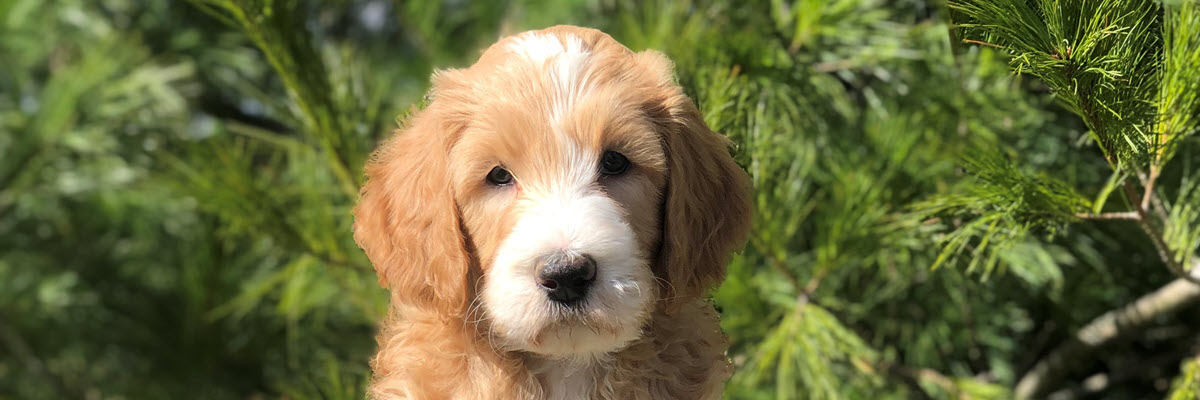
Additional Info
Grooming
A Goldendoodle puppy is crossbred of a Standard Poodle with a Golden Retriever. Both are breeds that require regular grooming as do Goldendoodles.
Keep in mind a puppy’s coat will change as it ages to some degree. So do not pick a puppy based solely on the coat type. You can sometimes tell what type of coat they may end up with by looking at the fur around the puppy’s face and muzzle. If you see crimping here then you are likely to end up with an adult with a wavy or curly coat but won’t know till they are older. If it is smooth then you’re likely to end up with a straighter coat.
Goldendoodles are typically very low shed dogs, but they do require regular grooming to keep their beautiful coats healthy and free of painful matting. How often your dog requires grooming depends on how long you prefer your dog’s coat to be and how much maintenance you are willing to do to at home. You should find a groomer that you like and get your puppy/dog on a regular schedule. During your regular grooming sessions, ask your groomer to also trim nails, pluck ears, and brush your doodle’s teeth.
Goldendoodles will have one of three coat types. Wavy, curly, or straight. We can tell you which coat your puppy most likely has based on knowing the parent’s coat types.
Wavy Coat
This is the most common Goldendoodle coat. It is referred to as wavy or shaggy. It is also an easier coat to take care of.
Brady is a Goldendoodle with a wavy coat.

Straight Coat
Straight coats are the easiest to maintain. They require minimal brushing.
Mae has a straighter coat.
.

Curly Coat
These curly coats will be loose ringlets or tight kinks like you find on a Poodle.
The curly coat is the most likely to develop matting if not properly maintained.
Bruce is a standard poodle with a curly coat.

Puppy Socialization
Socializing your puppy means teaching them to be well-behaved around other animals and humans. Socialization helps your puppy be comfortable in new environments and keeps them confident in new situations.
The first three months of your puppy’s life are important for their development. During these months, the desire to be social outweighs their fear.
What Age Is Best for Puppy Socialization?
There has been debate about whether you should socialize your puppy before they are fully vaccinated. However, puppies can handle new experiences best between 3 and 12 weeks old. After that stage, they become cautious about new things they haven’t encountered before.
We start puppy socialization before they leave our house. They are exposed to safe adult dogs, men, and women of many different ages along with many different sounds, textures, and situations. Puppies should continue socialization when they go home.
After the first 12 to 14 weeks of your puppy’s life, continued socialization and introduction to new environments are important. This reinforces good behavior. Keeping a positive environment is important for puppies to feel safe and secure while learning new things.
Why Is Puppy Socialization Important?
A well-socialized puppy creates a behaved, relaxed, safer dog. If your puppy is comfortable in a wider variety of situations, they’re less likely to use aggression in moments of fear. Not socializing your puppy can lead to dangerous situations in the future.
How Does a Puppy Need to Be Socialized?
There are different methods of puppy socialization: at home, in classes, or in puppy playdates. Socializing your new puppy also requires more than meeting new people and dogs.
Your puppy needs to be exposed to new sights, sounds, and textures. Letting children play with your puppy, in a controlled setting, and getting a variety of people to play with your puppy helps as well.
Do I Need to Do Anything Special When I Socialize My Puppy?
When socializing your puppy make sure to take it slow and be aware of your puppy’s limits. Make the interactions positive and give plenty of treats and praise. Everything is new to your puppy, so every encounter is an opportunity to make a positive association.
Try not to stress yourself when introducing your puppy to older dogs, as your puppy can pick up on that. Take baby steps and try to avoid doing too much at once. Take introductions to family and strangers slowly, if your puppy feels overwhelmed they may have a fearful reaction to large groups or settings in the future.
Training
Training is an essential part of owning a dog and can be started at any age. Training builds confidence, provides mental stimulation, and strengthens the human-animal bond. Dogs are always learning. It is never too late to start training.
Dogs that have anxiety or more timid personalities can benefit from training. It provides a sense of accomplishment and provides a way for us to communicate with our four-legged family members. This strengthens the bond we have with our dogs through positive attention. Plus, they can spend time with us, which is what most dogs want, to be close to us.
Mental stimulation is an important part of a dog’s overall well-being. It is just as vital as daily physical exercise. When it is too cold or rainy outside, going through basic training skills indoors can be the exercise our bored dogs need. Or if your dog must limit exercise due to an injury or after surgery, mental stimulation is necessary to keep them occupied.
Will training make my dog behave better?
Sometimes it is challenging for our dogs to understand what it is we are asking of them. This can cause frustration for both us and our dogs. Typically, what we think of as “bad” behavior is really normal dog behavior. These may include chewing on things or digging. Dogs explore their environment by using their noses, mouths, and paws. If these normal behaviors are not used in an appropriate way, they can lead to trouble. Dogs will learn to do things when people are not around. Dogs have no concept of right or wrong. It is up to us to teach our dogs what is “right.” If a dog is taught to chew on toys, he/she will look for these instead of your shoes. The key is consistency with training and it can take a time to achieve the exact results you want.
What method of training is recommended?
The preferred method of training is positive reinforcement. This consists of rewarding your dog for doing something “right.” Rewards can be treats, toys or praise. Training methods that use punishment can cause the “bad” behavior to get worse or even lead to aggression. There are many options for training – in person (groups or private), online, books, etc…
When should I start training my new puppy?
Right away! It is recommended to start training your puppy as soon as you get them home. Enrolling your puppy in a “Puppy Socialization” class will help with both socializing and beginning the early training process. Additionally, young dogs will go through an adolescent phase between 8 – 18 months when socializing and training can be important tools to keep your dog friendly and happy as they go through the “teenage years”.
My dog knows basic commands, why do I need to train him or her?
Obedience is the most common training, but there is also training for agility, nose work, therapy dogs, dock diving, trick dogs, and more.
The time you invest in training your dog is valuable for strengthening the relationship and trust between you and your dog.
Follow
Phone
517-526-1875
plattedoodles@gmail.com
